Basing House Open Days – Beyond the Brick Wall
As part of our time at Basing House, we were keen to work with the Hampshire County Council team to keep visitors informed of our dig, and to tell people all about the history of Basing House in an engaging way. The dig was also a training excavation; a compulsory part of an Archaeology or Archaeology & History student’s undergraduate degree. Basing House is a site that is open to the public six days a week over the summer season, and so we saw that there was a great opportunity for students to meet visitors to the site and to have an opportunity to experience talking about archaeology to a variety of people.
We had an extensive and very ambitious Outreach Programme planned for our three weeks. We managed to do almost everything that we had planned, but there’s still lots more that we would like to do!
Festival of British Archaeology Open Days
Over the three weeks that we were on site, we ran six Open Days. These were part of the Festival of British Archaeology, and as such were open to any member of the public visiting the site who had an interest in Archaeology. As part of their time at Basing House, each undergraduate student took part in designing and facilitating activities for the Open Day.
The photo below shows the trench surrounded by visitors on one of our Open Days. We were also lucky to have a visit on this day from Alan Turton, the previous Curator of Basing House, whose help and advice throughout the excavation season was invaluable. Alan made time to visit us numerous times during the excavation, and even took time out to give a tour of the Basing Grange farm complex for our student teams.
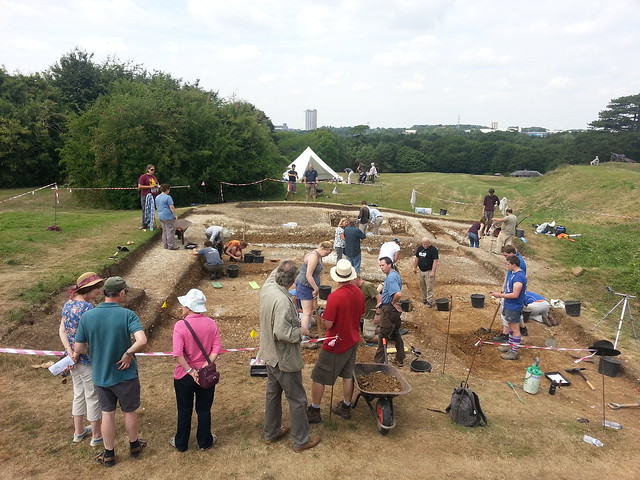
Visitors to the trench.

Students and volunteers manning the stalls for visitors.
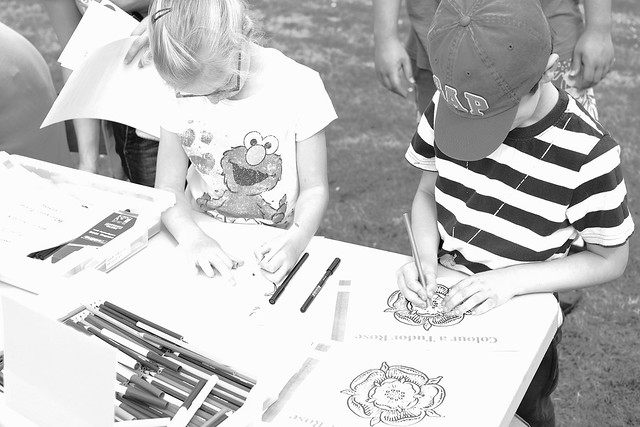
Young visitors to Basing House Open Day trying out some of the student-led activities.
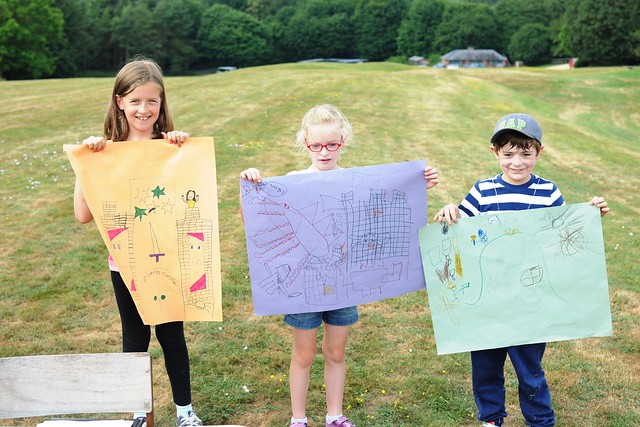
Young visitors to the Open Day stall proudly show off their artwork, based on the Civil War Siege of Basing House.
Visitor Centre Mini Exhibition
Students were also encouraged to give tours of the trench, and to create materials for a mini-exhibition which was on display in the Visitor Centre on site. In the photo below, Sam and Corinne are working on the first part of the Visitor Centre Mini Exhibition.
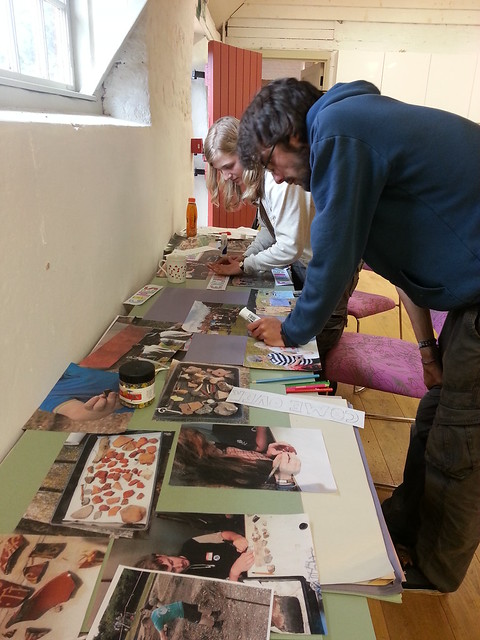
Sam and Corinne working on the mini exhibition content.
Bones Identification Day
Ellie and Richard gave up a whole day of working on their research to visit us and host a Bones Identification Workshop at one of our Open Days.

A part of the Bones Identification Workshop that Ellie and Richard ran. Our Bones Experts even set recreated the bones layout of an Iron Age horse burial!
Student Reporter
Each day, we had a new student reporter assigned to recording the day’s activities. The Student Reporter was the official Press Photographer for the day, and some excellent photographs were taken of finds as they came out of the ground. Here’s a photo of Lizzie’s hand holding the Roman coin that she has just found in the flint feature that she was excavating.

Lizzie holding the fourth Roman coin found during the dig.
Having a Student Reporter on site meant that we were able to quickly share information about the day’s findings as they happened. We uploaded photos to Flickr and shared them on our Facebook page. Then the following day, the Student Reporter put together a short blog post, summarising the previous day’s findings. Some students chose to focus on particular themes, and so some interesting topics were discussed on the blog.
Artist-in-Residence and Art Workshops
Peter Driver, our Artist-in-Residence, worked with students and volunteers over the three weeks on site, to produce monoprints and screenprints inspired by the archaeology. Here are Eddie and Phoebe etching on plates, just before they make monoprints with Peter.
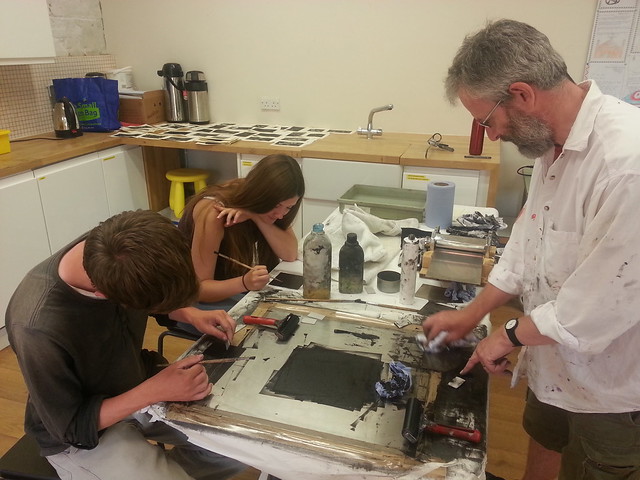
Phoebe and Eddie working on their monoprints with Peter, the Basing House Artist-in-Residence.
Peter also produced a series of zines, here he is cutting and folding the final edition. The zines were a great way to compile together the masses of activity and conversations occurring on site each day.
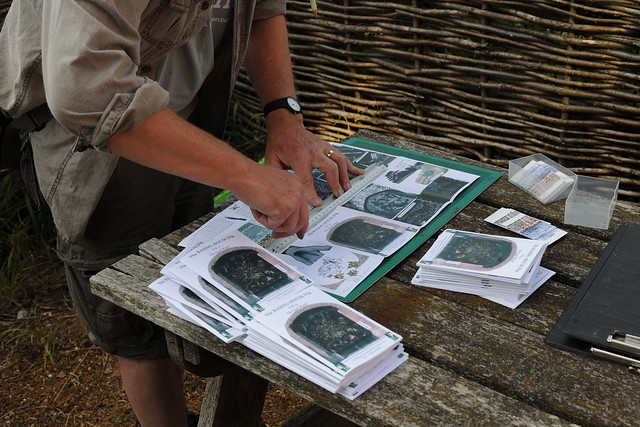
Peter, cutting and folding the last edition of the Basing House Summer Dig Zine.
Artists’ Open Day Workshops
Part way through the excavation season, Jeff and Mike, Winchester School of Art artists came to spend two days with us on site. Mike ran screenprinting drop-in sessions, coinciding with the Open Days. Here’s one of my favourite photos from the entire season; Milo Jones working on his screenprint with Mike.
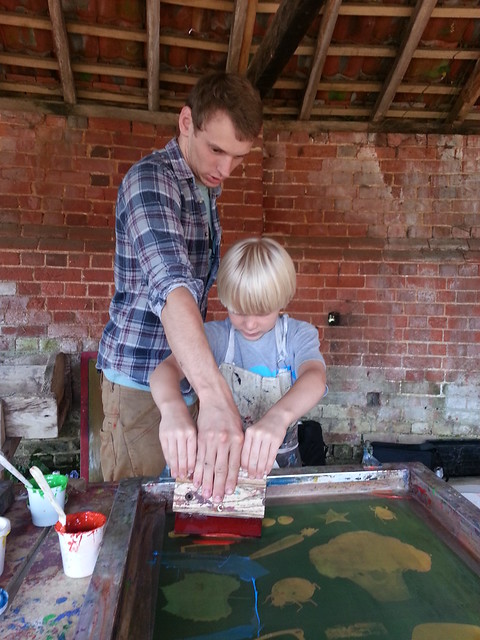
Mike, an artist from Winchester School of Art, working with Milo Jones a visitor to the site, to produce a screenprint, inspired by the history and archaeology of Basing House.

Visitor and team member screenprints drying in the sunshine.
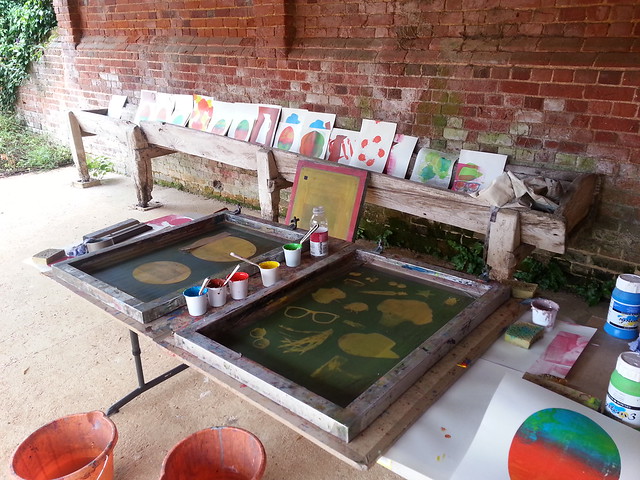
The impressive portable screenprint frames, made by Jeff.
Students, volunteers and also visitors to the site also made monoprints. Here is my own attempt:
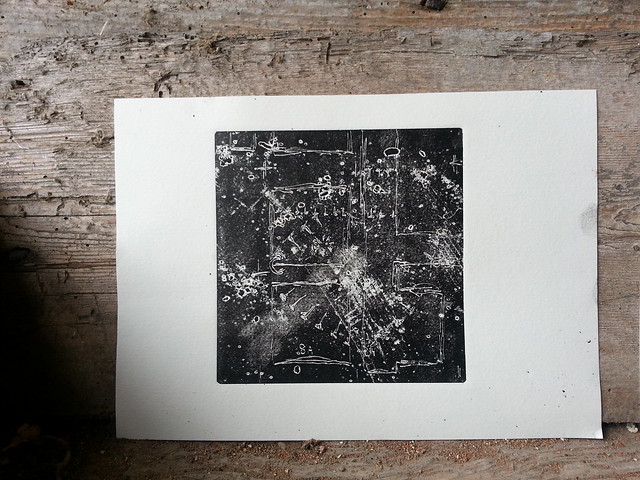
A student-produced monoprint, based on the 1960s trench drawing of the excavation. With an imprint from a tyre that had just been excavated from the topsoil of the trench.
Post Excavation Exhibition
The next phase of the Basing House Outreach Programme is to put together a travelling exhibition. The exhibition will visit different venues in Hampshire and will be a reflection on the Basing House Spring 2013 Geophysics Survey Season and the Basing House Summer 2013 Excavation Season. We’re hoping to work with members of the survey and excavation team, both students, artists and volunteers, as well as making connections with new team members, from the University of Southampton, Hampshire Museums Service, Winchester School of Art, and the areas around Basing House.
We’ve already got lots of material to work into the exhibition, including: the monoprints, screenprints, zines, photos (taken by a different student each day), the computational outputs, finds, drawings, sketches, and the more traditional archaeological data. Then there are the student’s journalistic reports, the trench diaries, interviews with volunteers, and the blog posts. So plenty of material to begin with!
We’d love to have more volunteers to get involved in this next stage of the Outreach, so if you’d like to get involved, drop us an email: nicole.beale@soton.ac.uk
Beyond the Brick Wall – Basing House Open Days
—-
Chris Elmer has written an article for the forthcoming issue of our in-house Humanities Graduate School Newsletter, about the Open Days that we ran during the excavation season at Basing House. We’ve shared his thoughts here.
—-
Basing House is noted for the profusion of walls and boundaries, whether ditches, earth banks, walled gardens, gateways and even the temporary hazard tape surrounding the recent excavations jointly led by Hampshire Museums and the University of Southampton.
Although the work was primarily set up as a training dig for first year undergraduates, there was a desire to reach out beyond the boundaries of the hazard tape and the other boundaries to include public visitors to the site.
Basing House is open to the public six days a week and it was decided that we would encourage the student diggers to work with visitors, explaining the site but also going one step further and creating active experiences for family visitors.
The resources normally used by the Basing House Education team were made available to us and over the three weeks of excavation we provided two days each week which were advertised as special open days for family visits.
Students created a range of interactive games and activities from piecing broken pots together to an archaeological take on snakes and ladders (called buckets and barrows). Over 160 visitors took part in the activities which were advertised by the site and the feedback from surveys undertaken by site staff were overwhelmingly positive. Viewing an excavation from beyond the hazard tape provides a very passive encounter with the past, but combining this with student enthusiasm and an invitation to make and take, play a game or guess the animal skull transforms the experience to one that is both fun and memorable.
–
Chris Elmer
Filed under: Archaeologist Portraits, Artist in Residence, Digital Methods, Events, Festival of British Archaeology, Images, Media Coverage, Open Days, Student Reporter, Summer Excavation, Winchester School of Art Tagged: chris-elmer, education, open days, public, visitors


